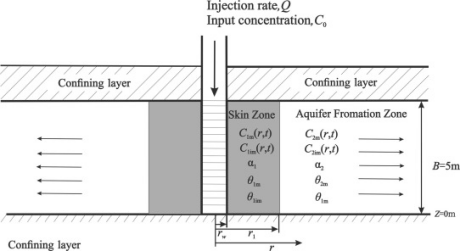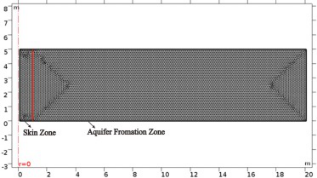“A mobile-immobile model for reactive solute transport in a radial two-zone confined aquifer” was published in Journal of Hydrogeology (Volume 580, January 2020, 124347). It is an achievement of Prof. WEN Zhang’s team from the School of Environmental Studies. The first author is second-year doctoral student XIE Shuang, and WEN is the corresponding author.
A mobile-immobile model (MIM) of reactive solute transport for an injection well was investigated in a radial two-zone confined aquifer system made up of the aquifer formation zone and the wellbore skin zone evolving from mud invasion or extensive well development. Fundamental transport processes such as advection, radial dispersion, first-order reaction, linear sorption and first-order mass transfer between the mobile and immobile domains were considered. The Laplace transform and numerical inverse Laplace methods were used to solve the model while the skin effect on the spatial concentration distribution as well as breakthrough curves (BTCs) were analyzed. The results indicate that a larger dispersivity or smaller effective porosity in the skin zone result in higher values of BTCs at the early injection stage, lower values at the late stage and higher peak values of BTCs. However, an abrupt change for the spatial concentration distribution was observed at the interface of the skin and aquifer formation zones due to the dispersivity change in the skin zone. It was also found that a larger mass transfer coefficient of the skin zone results in smaller values of BTCs at the early injection stage but higher at the late stage. The general conclusion is that the possible impacts of skin on radial solute transport are significant and should be taken into consideration in tracer-injection tests.

Fig. 1. Conceptual model of a two-dimensional (2-D) in two-zone skin confine aquifer system, and the first zone is the skin zone; the second zone is the aquifer formation zone.

Fig. 2. Details of the mesh used in two-zone skin confine aquifer system based on finite-element COMSOL Multiphysics.

Fig. 3. Comparison between the analytical solutions (ADEs) of this study and the numerical solutions based on finite-element COMSOL Multiphysics.
Full Text: https://doi.org/10.1016/j.jhydrol.2019.124347